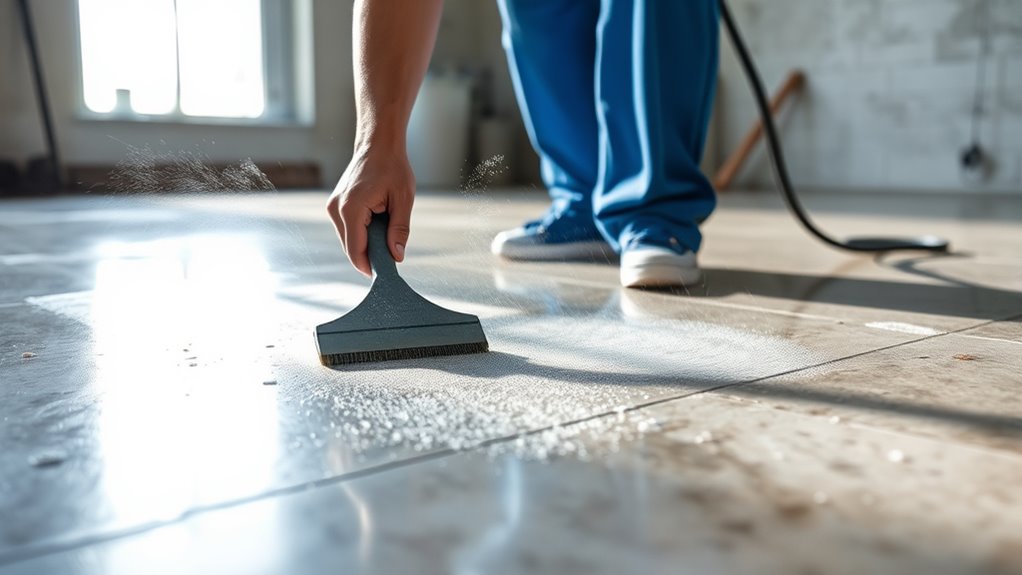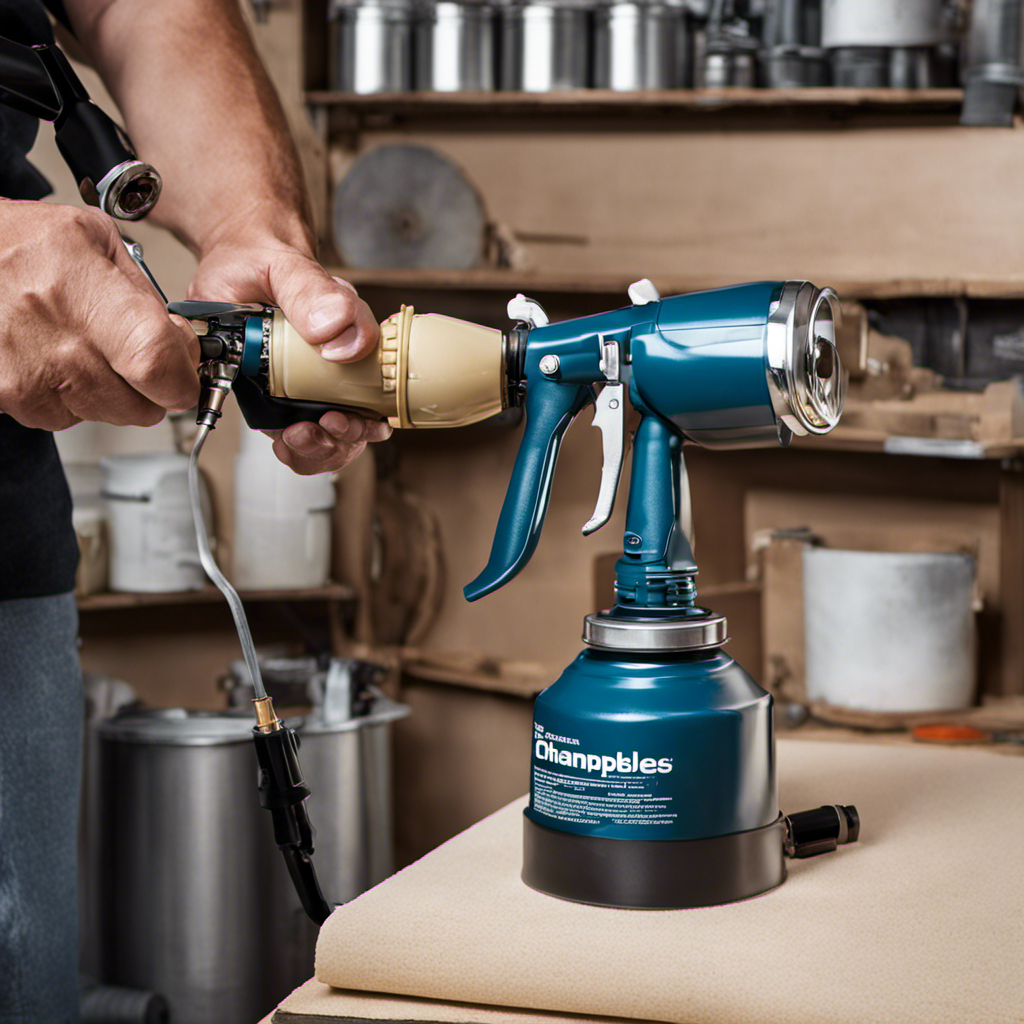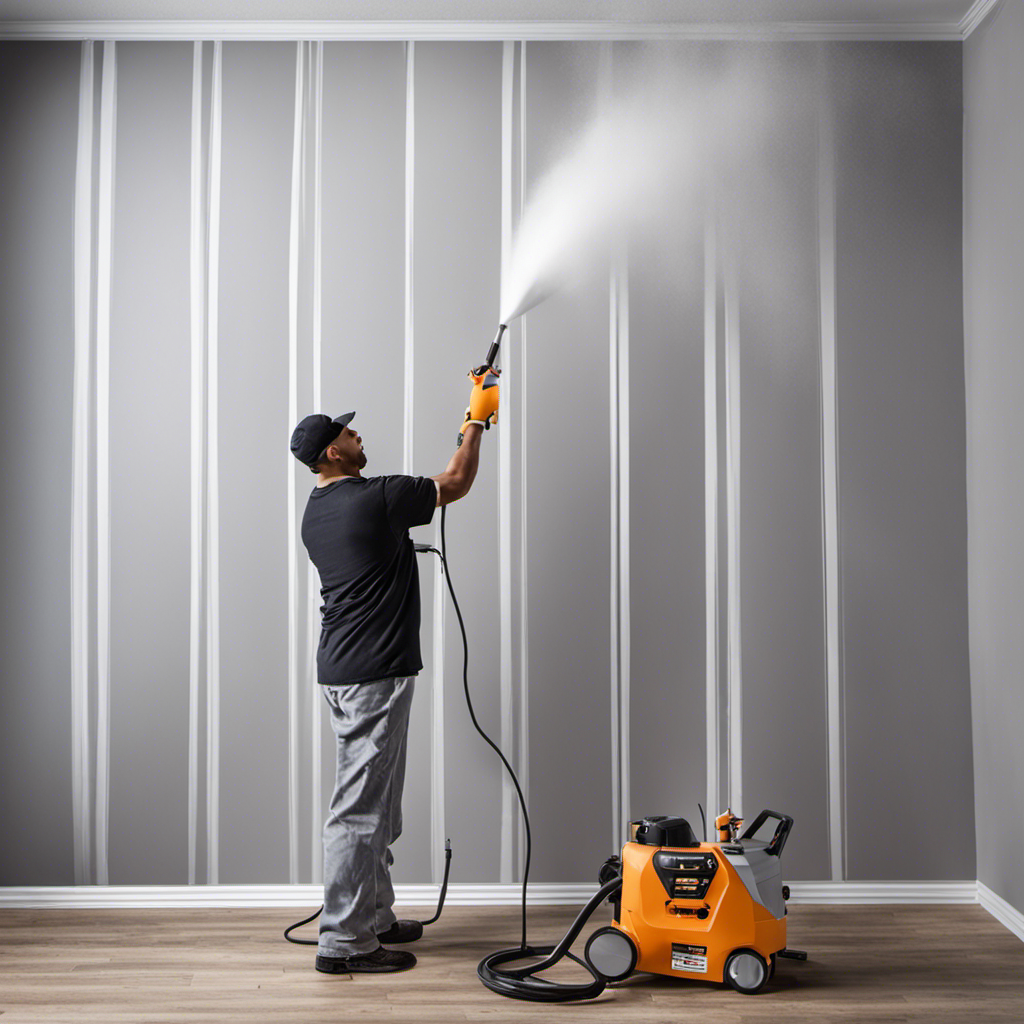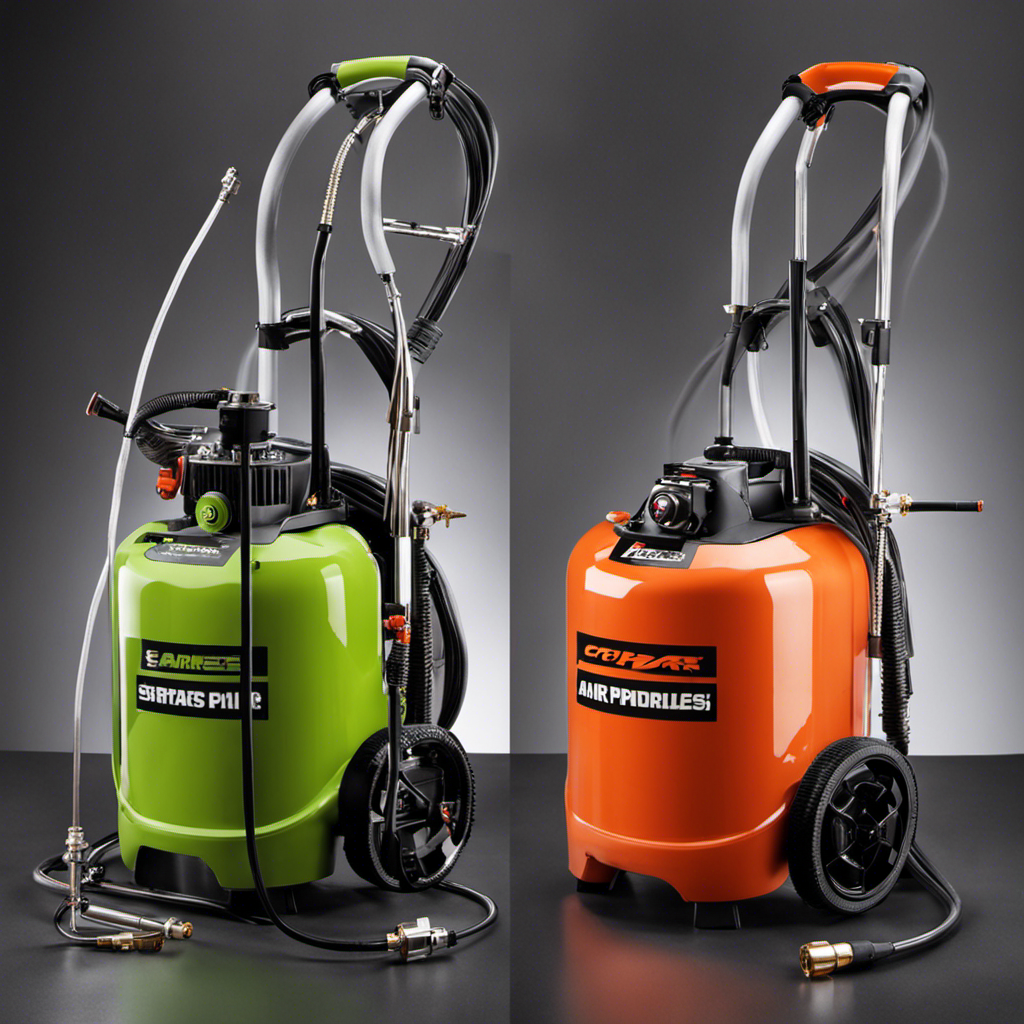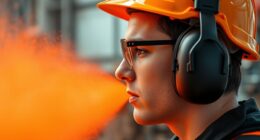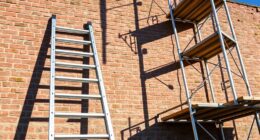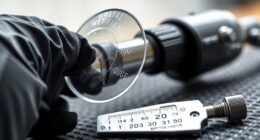To clean up paint overspray from floors and surfaces, start by identifying the type of overspray and surface material to select the right removal method. Use tools like scrapers, brushes, or specialized cleaners—such as soap, alcohol, or commercial paint removers—depending on the situation. Protect surrounding areas with drop cloths and proper masking. For best results, follow proper techniques and safety precautions, and you’ll find that detailed tips can make your cleanup easier and more effective.
Key Takeaways
- Assess the type of overspray and surface material to choose appropriate removal methods and prevent damage.
- Use plastic scrapers, brushes, and suitable solvents like soapy water or commercial removers for effective paint mist removal.
- Protect surrounding areas with drop cloths, painter’s tape, and plastic sheeting to contain overspray and facilitate cleanup.
- Test cleaning solutions on small areas first to avoid surface damage and follow manufacturer instructions for best results.
- Act promptly, regularly inspect the area, and seal surfaces if necessary to prevent future overspray buildup.
Assessing the Type of Overspray and Surface Material

Before attempting to remove overspray from floors, you need to identify both the type of overspray and the surface material. Understanding paint adhesion helps you determine how firmly the paint bonds to the surface, which influences your cleaning approach. For example, high-adhesion paints may require specific solvents or scrapers. Additionally, surface porosity plays a vital role; porous surfaces like concrete absorb paint differently than smooth, non-porous surfaces like tile or hardwood. Porous materials may trap overspray deeper, making removal more challenging. Evaluating these factors guarantees you choose the right cleaning method and avoid damaging the surface. Recognizing the importance of surface properties can help guide your cleaning strategy to achieve the best results. By carefully analyzing the overspray and surface type, you set yourself up for a successful cleanup that preserves the floor’s integrity.
Gathering the Right Tools and Supplies for Cleanup
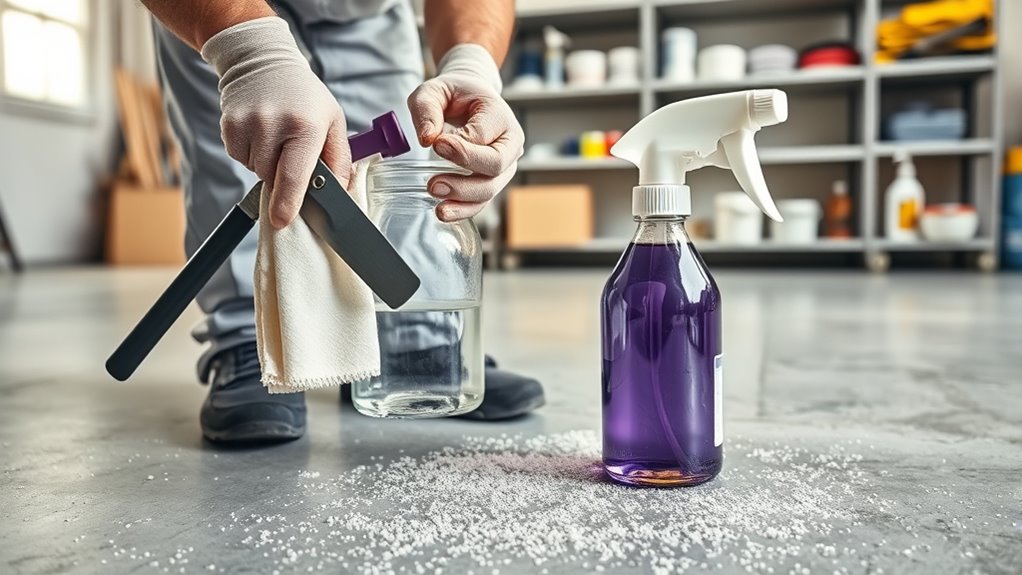
To effectively remove overspray from floors, gathering the right tools and supplies is vital. Start with basic cleaning supplies like microfiber cloths, scrub brushes, and buckets of water. For paint removal, have a variety of paint removal tools such as plastic scrapers or putty knives to gently lift paint without damaging the surface. You might also need specialized cleaning solutions like mild solvents or commercial paint removers, depending on the type of paint and surface. Gloves and protective gear are essential to keep yourself safe during the process. Keep rags, sponges, and a shop vacuum handy for quick cleanup. Having the right supplies ready ensures you can efficiently tackle overspray and minimize the effort needed for a thorough cleanup. Incorporating sound vibrations into your cleaning routine can also help loosen stubborn paint residues and enhance overall surface restoration. Additionally, understanding the importance of headphone compatibility can be useful if you need to listen to instructions or music while working.
Preparing the Area for Safe and Effective Removal
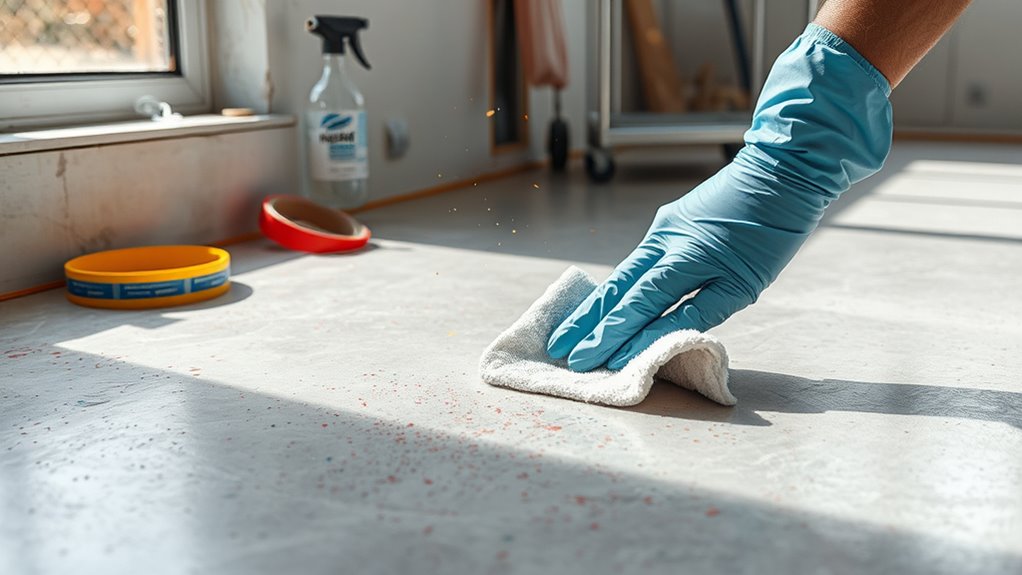
Before removing overspray, you need to prepare the area to guarantee safety and effectiveness. Clear the work zone of any obstacles, and cover nearby surfaces to protect them from potential damage. Taking these steps now saves you time and reduces the risk of accidents during cleanup. Additionally, considering the use of specialized cleaning products like eye patch benefits can aid in gentle and effective removal of paint residues. Using diverse planter designs or eco-friendly cleaning solutions can also enhance the overall safety and efficiency of your cleanup process. Selecting vetting cleaning agents that are safe for your surfaces ensures optimal results without damage. Incorporating water-based solutions can further minimize chemical exposure and environmental impact during cleanup. Ensuring the authenticity of your cleaning products by checking for brand reputation can help guarantee quality and safety in your cleaning process.
Clear the Work Zone
Ensuring the work zone is clear is essential for safe and efficient overspray removal. You want to prevent accidents and make the cleanup process smoother. Start by removing any tools, equipment, or personal items from the area. Clearly mark the work zone with signs or barriers to alert others of the ongoing work. This helps maintain safety precautions and keeps untrained individuals away from potential hazards. Make sure the floor is free of obstacles that could cause slips or trips. If needed, temporarily shut off nearby electrical outlets or lights to avoid interference. A clear work zone minimizes risks and allows you to focus solely on the overspray removal task, ensuring a safer, more effective cleanup process. Creating designated zones can also help organize your workspace and streamline the cleanup process. Additionally, understanding the horsepower of electric dirt bikes can be useful if you’re considering mobility options for equipment transportation during larger cleanup projects. Knowing how cookie preferences influence your browsing experience can help you better manage online safety and privacy while researching cleaning techniques. Being aware of market volatility can also inform your planning for large projects, ensuring you have the right resources in place.
Protect Adjacent Surfaces
Protecting adjacent surfaces is essential to prevent damage and make cleanup easier. Using surface protection materials like drop cloths, plastic sheeting, or painter’s tape creates a barrier against overspray. This overspray prevention ensures paint mist doesn’t settle on unintended areas, saving time and effort later. Additionally, understanding overspray prevention techniques can further enhance your project’s efficiency, especially as advancements in automation in business make project planning more precise. Using the right protective measures is crucial in achieving a rustic farmhouse look while maintaining a clean workspace. Proper surface protection minimizes cleanup and prevents costly damage. Moreover, selecting appropriate materials and techniques can help address surface types specific to your project, ensuring comprehensive coverage and protection. Incorporating precious metals IRA strategies can also serve as a safeguard for your long-term investments, much like protecting your surfaces from overspray.
Techniques for Removing Paint From Hard Floors and Surfaces
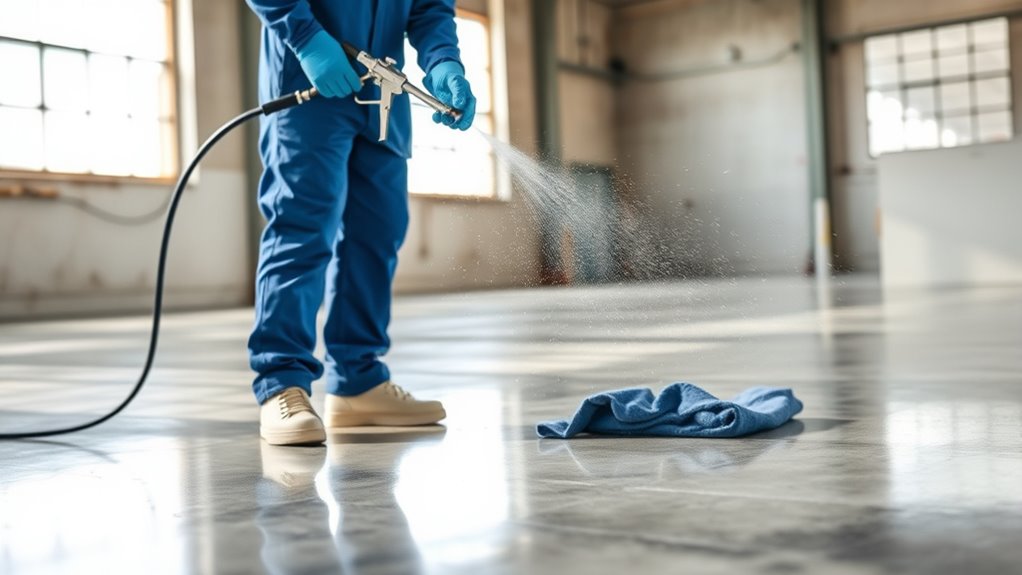
Removing paint overspray from hard floors and surfaces requires prompt action and the right techniques. First, guarantee proper surface preparation by removing loose paint and debris with a soft brush or vacuum. Next, choose your paint removal method based on the type of surface and paint. Here are some effective techniques:
- Use a plastic scraper or putty knife to gently lift dried paint without scratching. Incorporating proper surface preparation can also minimize surface damage and improve the overall outcome.
- Apply a mild solvent like soapy water or rubbing alcohol for water-based paints. Understanding technology in energy distribution can help in selecting environmentally friendly solvents that reduce chemical use.
- For tougher spots, consider using a commercial paint remover, following manufacturer instructions carefully.
- Always test a small, hidden area first to prevent damage. Proper surface preparation is key to making paint removal easier and avoiding surface damage. Acting quickly and selecting the right method ensures a cleaner, safer result.
Using Specialized Products to Break Down Paint Mist
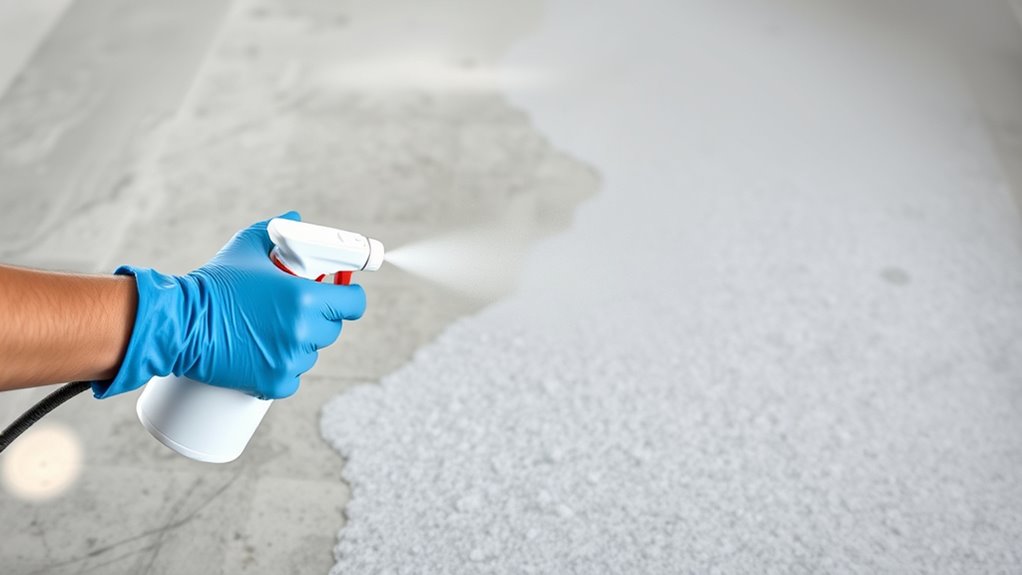
After you’ve addressed paint splatters on the surface, tackling paint mist lingering in the air and settling on nearby areas becomes the next challenge. Using specialized products can make paint mist removal easier and more effective. Look for overspray cleanup solutions designed to break down fine paint particles without damaging surfaces. These products often contain solvents or surfactants that dissolve paint mist, allowing you to wipe or rinse it away easily. Apply the product according to the manufacturer’s instructions, ensuring you cover all affected areas. Using the right cleaner not only speeds up the process but also prevents streaks or residue. Proper application is key to achieving thorough overspray cleanup and restoring your surfaces to their original condition efficiently. Additionally, selecting a product formulated for surface safety can help prevent unintended damage during cleaning. Incorporating effective cleaning agents that are compatible with your surfaces ensures a thorough and safe cleanup process. Understanding paint composition can also help you choose the most suitable cleaning method, ensuring effective removal without harming your surfaces.
Tips for Preventing Overspray During Future Projects
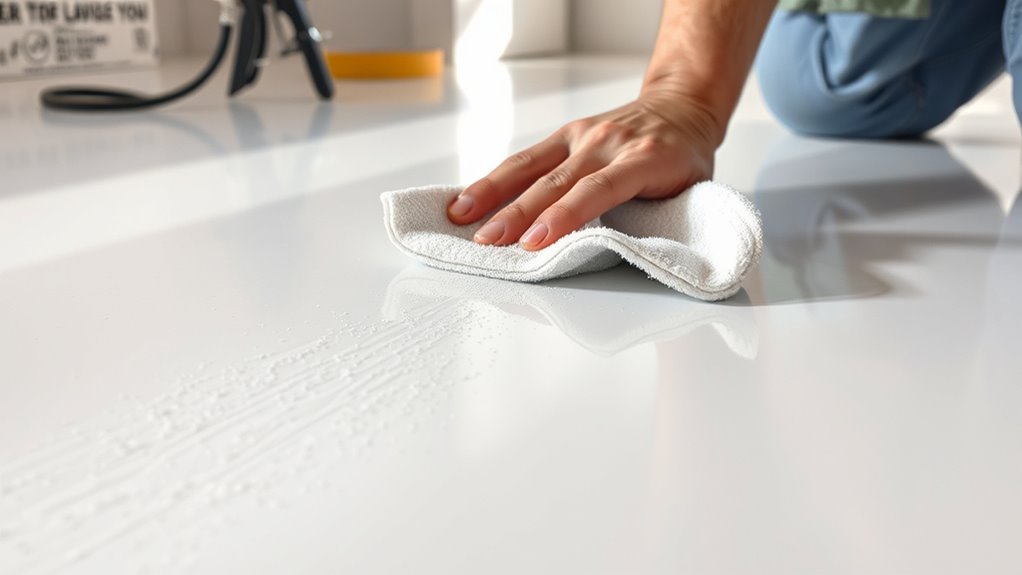
To keep overspray off your floors, start by using drop cloths properly to cover all surfaces. Make sure you apply masking tape effectively to protect edges and prevent paint from spreading. Additionally, control your spray distance to maintain a safe and precise spray pattern that minimizes overspray.
Use Drop Cloths Properly
Using drop cloths properly is essential for preventing overspray from ruining your floors during painting or staining projects. To do this effectively, focus on correct drop cloths placement and surface masking. Here are key tips:
- Cover all exposed floor areas with a large, heavy-duty drop cloth, ensuring it extends beyond the work zone.
- Secure the edges with painter’s tape or weights to prevent movement and gaps.
- Use multiple cloths if necessary, overlapping seams for better coverage.
- Always inspect and adjust the cloths during the project to maintain proper surface masking and prevent overspray from sneaking underneath.
- Being aware of overspray prevention techniques can significantly reduce the need for extensive cleanup afterward. Additionally, choosing the right type of drop cloths made from durable materials can enhance protection against paint splatters.
Proper use of drop cloths helps keep your floors clean and reduces the need for cleanup after your project.
Apply Masking Tape Effectively
Applying masking tape correctly enhances your efforts to prevent overspray during future painting projects. Start with thorough surface preparation; clean and dry surfaces to guarantee proper adhesion. Press down the masking tape firmly along edges, ensuring it sticks well to the surface. Use high-quality masking tape designed for paint jobs, which minimizes bleed-through. Apply tape in straight, even lines, avoiding wrinkles or gaps that could allow overspray to seep underneath. For complex areas, use small pieces of tape and carefully press the edges down. Removing the tape at the right time, while paint is slightly tacky, helps create clean lines. Proper surface preparation combined with effective tape application considerably reduces overspray and results in a cleaner, professional finish. Additionally, choosing tape with odor control features can help manage any residual fumes during the painting process. Using tapes with strong adhesion properties ensures that the tape remains securely in place throughout the project, further preventing overspray.
Control Spray Distance
Controlling your spray distance is essential for preventing overspray and achieving a clean finish. When you keep the right distance, you reduce paint mist that settles on unintended surfaces. To do this effectively:
- Adjust your spray gun calibration to maintain a consistent spray pattern.
- Keep the spray gun about 6-12 inches from the surface, depending on the paint viscosity.
- Test spray on a scrap surface to check for over- or under-spray.
- Modify your distance based on the paint’s thickness; thicker paint may require closer proximity for even coverage.
Final Steps: Ensuring a Spotless Finish and Protecting Your Space
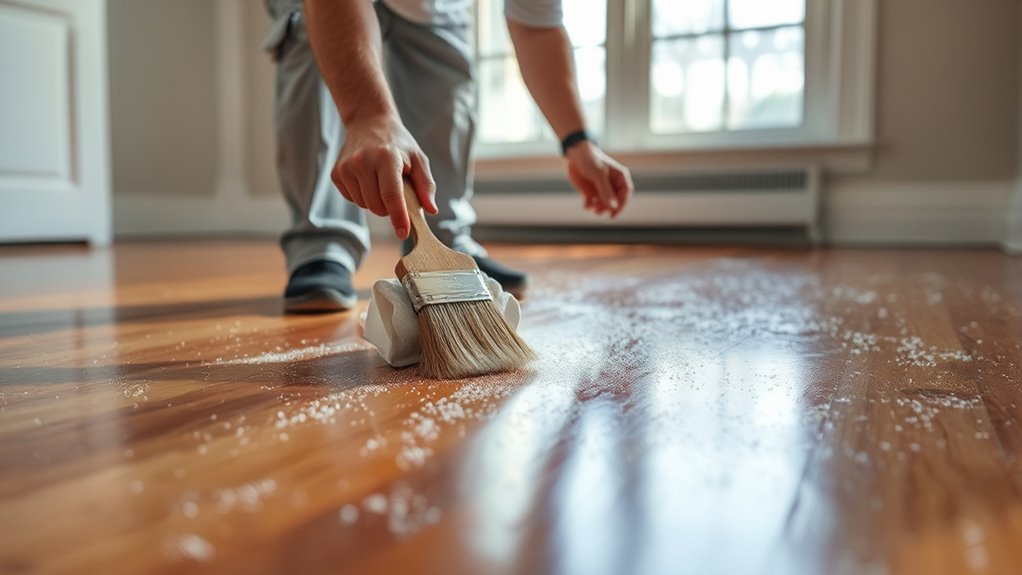
After thoroughly removing overspray, it’s essential to focus on finishing touches that guarantee a spotless look and long-lasting protection. Applying a protective sealant or wax can enhance paint protection and make future overspray prevention easier. Confirm surfaces are completely clean by doing a final wipe-down with a gentle cleaner. Use the table below to review your steps for a flawless finish:
| Step | Action | Purpose |
|---|---|---|
| 1 | Clean surfaces | Remove residual dust or paint specks |
| 2 | Inspect for missed spots | Ensure thoroughness |
| 3 | Apply sealant or wax | Protect surface and prevent overspray buildup |
| 4 | Cover areas | Use drop cloths or plastic sheeting |
| 5 | Maintain regularly | Keep surfaces pristine and protected |
These final steps help you achieve a spotless space while ensuring long-term paint protection.
Frequently Asked Questions
How Long Does Overspray Removal Typically Take?
The time it takes to remove overspray varies based on the area size and paint type. You should guarantee proper workshop ventilation and wear protective clothing for safety. Small spills might take just a few minutes, while larger surfaces could need several hours. Preparing your workspace and using appropriate cleaning tools can speed up the process. Remember, patience and safety measures are key to effective overspray removal.
Can Overspray Damage Underlying Surfaces or Finishes?
Imagine you’re in a time before surface protection, and paint contamination can easily damage your underlying surfaces or finishes. Overspray can cause permanent harm if not cleaned promptly, especially on delicate materials. It’s essential to assess the surface type beforehand. Proper surface protection minimizes damage, but if overspray isn’t removed carefully, it can etch or stain surfaces, leading to costly repairs. Always take precautions to safeguard your surfaces from paint contamination.
Are There Environmentally Friendly Cleanup Options?
You’re wondering if there are eco-friendly cleanup options for paint overspray. Luckily, you can use eco-friendly solvents and biodegradable cleaners that effectively remove paint mist without harming the environment. These products are safe for your surfaces, reduce chemical exposure, and break down naturally. By choosing biodegradable cleaners, you protect your surroundings while achieving a thorough cleanup, making your process more sustainable and less toxic.
What Safety Precautions Should I Take During Cleanup?
You might think safety precautions slow you down, but they protect you from harmful fumes. Always wear personal protective equipment like masks, gloves, and goggles to shield your skin and eyes. Guarantee proper ventilation strategies are in place to disperse paint mist and fumes, reducing inhalation risks. Taking these steps keeps you safe, allowing you to focus on your cleanup without worry. Prioritize safety to make the process effective and hazard-free.
How Can I Prevent Overspray in Windy Conditions?
To prevent overspray in windy conditions, you should set up wind barriers around your work area to block gusts. Additionally, use protective coverings like plastic sheeting or tarps to shield nearby surfaces and floors. These measures help contain the paint, ensuring it stays on your target surface. By taking these precautions, you reduce mess and improve the quality of your finish, even when the weather isn’t ideal.
Conclusion
Once you’ve cleared away the paint mist, imagine your floors and surfaces shining like a fresh morning breeze, spotless and renewed. With the right tools and techniques, you transform a messy overspray into a clean canvas, ready for your next project. Feel the satisfaction of a space restored, where every surface gleams under your careful touch. Now, enjoy your refreshed space, knowing you’ve mastered the art of cleanup and prevention.
A seasoned painter with over 15 years in the industry, Mike transitioned from hands-on painting projects to the digital world of paint sprayers. His extensive experience gives him a unique perspective on what users truly need when it comes to painting tools. As the Editor in Chief of Paint Sprayer Zone, Mike ensures that every piece of content not only provides value but also reflects the realities of painting — the challenges, the joys, and the intricate details.
